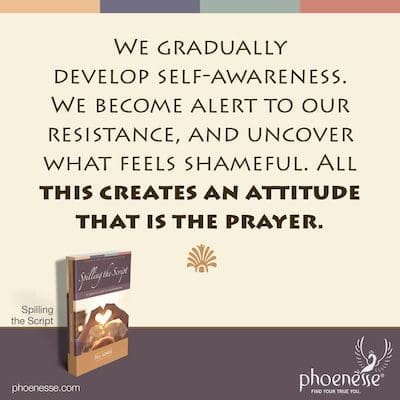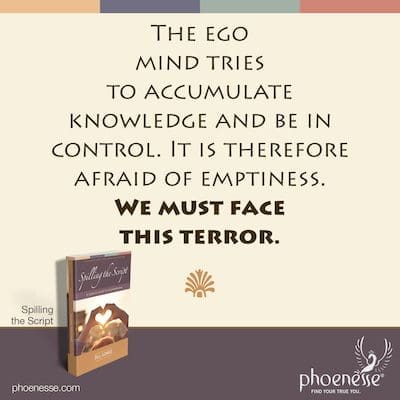As we do this work, we will come to know, through our own experiences, that what we experience is a reflection of what we believe. We will have this “knowing” because we will embody this truth, and not just know about it. Another truth we can come to know is that life is abundant. If that is not our current experience, we cannot just wish for what we want. We must eliminate the obstructions, which include images, faults and negative intention. The tools for doing this are prayer & meditation.
Meaningful meditation is a way to: check, test and challenge our concepts; seek truth and adjust our ideas and aims to it; and purify our feelings by going through them. And we can even use meditation to uncover what we should meditate about, or to help eliminate what prevents us from meditating.

As we progress through various stages of our journey, our relationship with prayer and meditation evolves. We begin in a place of being without awareness, where there is no prayer and no concept of God. As we begin to wake up and get curious about life, our wondering is the prayer and meditation.
We move to a realization of a supreme intelligence, perhaps from marveling at science or nature. Here we experience an admiration that is a form of worship. These progressions of course are not linear.
With this sense of God outside ourselves, we experience confusion, immaturity, and feelings of inadequacy that cause fear, clinging, helplessness, wishful thinking and greed. Our prayers are then petitions to this God outside of us.
From here we move into a more independent phase of atheism. There is no prayer to God, but we may look at ourselves sincerely. Or we may escape both God and the self through irresponsibility.
We gradually come to face the self and to develop self-awareness. There is more candor with the self and we become alert to our resistance, uncovering what feels shameful. All this creates an attitude that is the prayer. Slowly we arrive at a state of being, living in the eternal Now with love and awareness of God. This is the natural outcome of facing the self.

Creation requires the presence of both the active and the passive principles. The active is masculine and it is the “make it happen” energy. The passive, or receptive, is feminine and it is the “let it happen” energy. Both are needed for creation to happen. So to use prayer and meditation to create, we must combine intelligent thinking, which is the active prayer, with relaxing and listening to the divine, which is the receptive meditation.
We can learn concentration and discipline in the active state of prayer, cleansing our thoughts and getting clear about what we want help with. We do this by looking at every disharmony, no matter how insignificant, and asking: Where did I have negative feelings? What did I feel? Why did I feel that?
Then we use these qualities of concentration and discipline to sit in the silence and emptiness of meditation, listening. To be in balance, we should always turn our focus towards the one we find most difficult.
Four Steps for Prayer & Meditation
Concept | Active
- Clarify thoughts; remove obstacles.
- Conceive of new possibilities.
- Face the truth, feel feelings.
Impress Soul Substance | Receptive
- Relax inner will; remove defenses.
- Uncover unconscious currents.
- Allow inner truth, love, wisdom to surface.
- Drop in a seed and let it germinate.
- Do not disrupt it with doubt, fear, impatience.
Visualization
- Feel ourselves in the state we want to be in.
- Without particulars
Faith
- You cannot superimpose this.
- Have patience and examine doubts.
“Become very still and say these words inside of yourself: Be still and know I am God, the ultimate power. Listen to this power within, to this presence and to these intentions. I am God, everyone is God. God is all, in everything that lives and moves, that breathes and knows, that feels and is.
God in me has the power to make the separated little ego know the ultimate power to integrate this ego. I have the possibility to feel all my feelings—to deal with and handle all my feelings. This possibility is there in me, and I know this potentiality can be realized the moment I know it. And I now choose to know I can be alive; I have the strength to be weak and vulnerable.
So I can accept my numbness now, my insecurities, my feeling state and my nonfeeling state. And I can listen into this state and wait. I can be still and feel into me. And I can be still and hear my superior intelligence, the God intelligence, instruct me. I can establish this contact.
I will pay the price by giving the best I have and am to life. And I will live my life honestly in wanting to give the best. For then I will be able to receive the best without cringing. I do not fear to invest the best of myself into life.”
– The Pathwork Guide in Q&A #201
Learn more in Pearls, Chapter 2: Reading Between the Lines of the Lord’s Prayer, and in Bones, Chapter 18: How to Use Meditation to Create a Better Life.

Before we can be filled with joyful, positive creation, we must empty ourselves of our negativity and the rulership of the little ego. The ego mind, which is the self we most often identify with, is sustained by the “activity” by which it tries to accumulate knowledge and be in control. It is therefore afraid of emptiness, because in emptiness, it does not exist.
On a spiritual path, we eventually must come face to face with this terror. If we don’t, we will perpetually deceive ourselves as to the nature of reality—and to the ultimate nature of the real self.
But instead, we often identify with the busyness of the mind, and mistake the absence of busyness for emptiness. There are three paradoxes that must be accepted for creation to take place:
- If one cannot tolerate emptiness, one will never be filled.
- One must be expectant and receptive without preconceived ideas or wishful thinking.
- One needs to be specific in his or her longing and expectations, yet this specificity must be light and neutral.
Learn more in After the Ego, Chapter 12: Creating from Emptiness, and Chapter 17: Inner Space, Focused Emptiness
Return to Spilling the Script Contents



